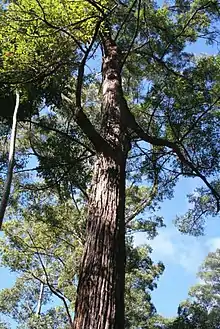Eucalyptus siderophloia
Eucalyptus siderophloia, commonly known as the northern grey ironbark,[3] is a medium-sized to tall ironbark tree that is endemic to south eastern Australia. It has hard, dark, furrowed bark, lance-shaped to curved adult leaves, flower buds in groups of seven, white flowers and cup-shaped or conical fruit.
| Northern grey ironbark | |
|---|---|
 | |
| Eucalyptus siderophloia at Mount Mellum | |
| Scientific classification | |
| Kingdom: | Plantae |
| Clade: | Tracheophytes |
| Clade: | Angiosperms |
| Clade: | Eudicots |
| Clade: | Rosids |
| Order: | Myrtales |
| Family: | Myrtaceae |
| Genus: | Eucalyptus |
| Species: | E. siderophloia |
| Binomial name | |
| Eucalyptus siderophloia | |

Description
Eucalyptus siderophloia is a tree that typically grows to a height of 20–45 m (66–148 ft) and forms a lignotuber. It has hard, rough, furrowed grey or black bark on the trunk and branches, sometimes smooth on the thinner branches. Young plants and coppice regrowth have egg-shaped to lance-shaped leaves that are paler on the lower surface, 50–120 mm (2.0–4.7 in) long and 15–48 mm (0.59–1.89 in) wide. Adult leaves are the same shade of green on both sides, lance-shaped to curved, 85–175 mm (3.3–6.9 in) long and 15–30 mm (0.59–1.18 in) wide, tapering to a petiole 10–25 mm (0.39–0.98 in) long. The flowers are mostly arranged on the ends of branchlets in groups of seven on a branched peduncle 5–12 mm (0.20–0.47 in) long, the individual buds on pedicels 2–8 mm (0.079–0.315 in) long. Mature buds are diamond-shaped or spindle-shaped, 5–10 mm (0.20–0.39 in) long and 3–4 mm (0.12–0.16 in) wide with a conical operculum. Flowering mainly occurs from September to January and the flowers are white. The fruit is a woody cup-shaped or conical capsule 3–8 mm (0.12–0.31 in) long and 4–7 mm (0.16–0.28 in) wide with the valves near rim level.[3][4][5][6]
Taxonomy and naming
Eucalyptus siderophloia was first formally described in 1867 by George Bentham in Flora Australiensis.[7][8] Terri-barri is an Aboriginal word from the Sydney region. The specific epithet (siderophloia) is derived from Greek words meaning "iron" and "bark".[9]
Distribution and habitat
This ironbark grows in forests on the coast and adjacent foothills in soils of reasonable fertility, from about Maryborough and Springsure in Queensland to near Sydney in New South Wales.[3][4]
Uses
The sapwood is usually resistant to the lyctus borer. Not an easy timber to work, however it has a beautiful appearance similar to some rainforest species. Uses include flooring and decking, shipbuilding, poles, construction, railway sleepers and heavy engineering.
References
- Fensham, R.; Laffineur, B.; Collingwood, T. (16 April 2019). "Eucalyptus siderophloia". IUCN Red List of Threatened Species. 2019: e.T133377033A133377035. doi:10.2305/IUCN.UK.2019-3.RLTS.T133377033A133377035.en. Retrieved 26 June 2023.
- "Eucalyptus siderophloia". Australian Plant Census. Retrieved 22 December 2019.
- Chippendale, George M. "Eucalyptus siderophloia". Australian Biological Resources Study, Department of the Environment and Energy, Canberra. Retrieved 22 December 2019.
- "Eucalyptus siderophloia". Euclid: Centre for Australian National Biodiversity Research. Retrieved 29 May 2020.
- Hill, Ken. "Eucalyptus siderophloia". Royal Botanic Garden Sydney. Retrieved 22 December 2019.
- Brooker, Ian; Kleinig, David (1990). Field Guide to Eucalypts (Volume 1). Melbourne: Inkata Press. p. 255. ISBN 0909605629.
- "Eucalyptus siderophloia". APNI. Retrieved 22 December 2019.
- Bentham, George; von Mueller, Ferdinand (1867). Flora Australiensis. London: Lovell Reeve and Co. p. 220. Retrieved 22 December 2019.
- Robinson, Les (1991). Field guide to the native plants of Sydney. Kenthurst: Kangaroo Press. p. 49. ISBN 0864171927.
